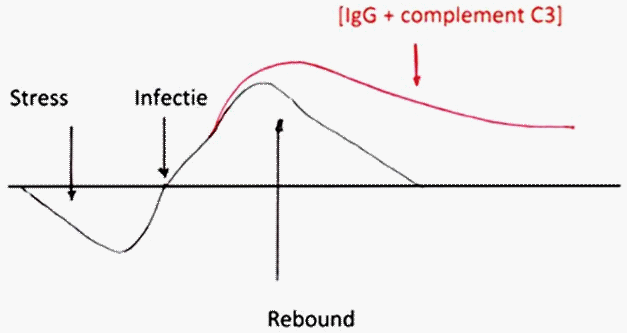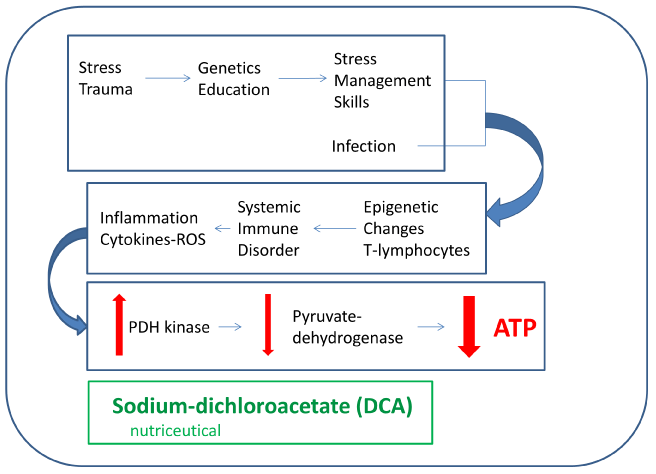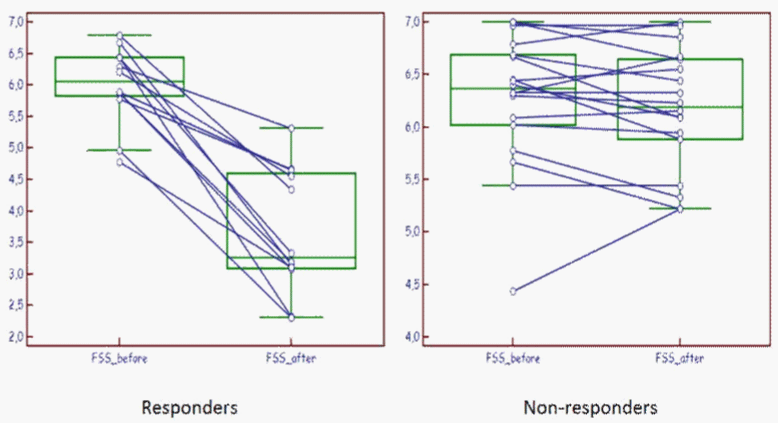
Special Article - Chronic Fatigue Syndrome
Austin J Womens Health. 2018; 5(1): 1028.
ME/CFS: Does the Flag Cover the Cargo? On the Pathogenesis and Treatment of an Enigmatic Disease
Frank Comhaire*
Department of Endocrinology, University Hospital Gent, Belgium
*Corresponding author: Frank Comhaire, Brakelmeersstraat, 18; B9830 Sint Martens-Latem, Belgium
Received: May 25, 2018; Accepted: July 10, 2018; Published: July 17, 2018
Abstract
Many patients suffering from unexplained long-lasting fatigue and cognitive deficiency are diagnosed to suffer from Myalgic Encephalitis/Chronic Fatigue Syndrome (ME/CFS) based on different lists of criteria. In reality, approximately one third of these patients seem to present an immunological/inflammatory/metabolic disorder resulting from poor stress management, an acute traumatic experience or infection. A holistic approach together with nutriceutical treatment using sodium dichloroacetate may improve their condition, sometimes to the point of complete recovery. In approximately one third of cases thorough biological and imaging investigations reveal a serious medical disease which needs specific treatment. In the remaining third of patients the pathogenic mechanism remains elusive but supportive treatment may be offered with a combination of vitamins, antioxidants, natural anti-inflammatory plant extracts, and phyto-adaptogens. Novel treatment options are under investigation including repetitive transcranial magnetic stimulation and hyperbaric oxygen therapy.
Keywords: ME/CFS; Chronic fatigue syndrome; Sodium dichloroacetate; Nutraceutical; Systemic immune disorder; Phytotherapy
Introduction and Pathogenesis
In recent decades the prevalence of ME/CFS seems to have increased, particularly among women living in certain parts of the world. There is no unequivocal explanation for this, though the profound changes in the environment, in nutrition and hygiene may be involved. Man-made chemicals with hormone-disrupting effects, xeno-estrogens in particular [1], are present in huge amounts in the environment, in our nutrition, and in many objects with which we are constantly in contact, such as clothing and cosmetics. Also, the agro-industry has introduced a multitude of different so-called crop-protecting agents, that accumulate in the biological chain and in human fat tissue. Increased hygiene results in several viral diseases to occur later in life [2], since first infection with e.g. the herpes viruses 4 (Epstein-Barr) and 5 (Cytomegalovirus) is commonly postponed until after puberty. This and the excessive use of antibiotics may profoundly influence the immune defence capacity [3].
At the other hand, concepts of children’s education have shifted from authoritarian to indulgent-protective, which may have made adults possess weaker stress management skills [4].
Persons with a genetic or acquired predisposition may be more prone to epigenetic changes when exposed to stressful events or external aggression, affecting their immune system. Due to epigenetic DNA changes [5] the T-lymphocytes may over-react by the excessive production and secretion of immunoglobulin IgG (Figure 1). This will bind to complement to create the [IgG-C3] complex that is cytotoxic provoking inflammation, with increased release of cytokines [6] and Reactive Oxygen Species (ROS).
Pyruvate originates from glucose by glycolysis. Inhibition of the activity of PDH will decrease the input of the substrate CoA into the aerobic energy-generating Kreb’s cycle, which results in reduced production of Adenosine Triphosphate (ATP).
Mitochondrial function being impaired, the cells activate the rescue anaerobic solution to produce ATP via the Cori cycle and the generation of lactate and lactic acid. Recent studies by the group of Ronald Davis of Stanford University seem to support this hypothesis. These researchers have demonstrated that the serum of patients with severe ME/CFS impairs the process of energy production by healthy cells in vitro when these are submitted to stress. Remarkably, this phenomenon is reversed by adding either pyruvate or ATP Taken together, there is strong evidence that substances in serum that are the result of immune dysfunction, inflammation and ROS cause deficient mitochondrial energy production, and accumulation of lactic acid resulting in the clinical signs and symptoms that are characteristic for ME/CFS (Figure 2).
Therapeutic Strategy and Options
General considerations
The first step in rational medicine is trying to detect pathogenic factors that may cause a particular person to suffer from a disease or syndrome. If such factors are found, treatment should aim at curing these causes, whenever possible.
In the absence of causal factors or possible causal treatment, therapy should aim at interfering with the mechanisms that are involved in producing the signs and symptoms. This approach is called “organ-targeted” treatment, and is the second best in case treatment of causal factors is either impossible, or has failed, or has generated an insufficient result. It is of the utmost importance that the treatment may not provoke damage by itself, as already proclaimed by Hippocrates of Koss: “first do not harm” (primum non nocere). The weakest form of treatment aims at combatting the signs and symptoms, without correcting either the causes or the mechanisms of the disease. Symptomatic treatment should equally respect the “first do not harm” rule, and must – as much as possible - be limited in time and intensity.

Figure 1: Long-lasting and/or severe stress from professional, emotional
or socio-economical origin may suppress the immune system. After the
suppression the system may rebound. Immunity may also be stimulated by
infection, usually caused by viruses, but also by specific bacteria. Whereas
the production and secretion of immunoglobulins normally tapers off after
some time, the level of Immunoglobulin G (IgG) is excessive and continuous
(red line) in patients with ME/CFS because of epigenetic changes of DNA of
the T-lymphocytes.

Figure 2: One molecule of glucose is split into 2 pyruvate molecules
by glycolysis that takes place in the cell cytoplasm. Pyruvate enters the
mitochondria where it is enzymatically converted to Coenzyme A (CoA) that
immediately binds to an acetyl group, generating acetyl-CoA. The process
requires the availability of a sufficient amount of oxygen, and is facilitated by
the enzyme Pyruvate Dehydrogenase (PDH). Fatty acids bind to Acetyl-CoA
to enter the aerobic metabolism of the Kreb’s cycle, together with citric acid and
several amino acids. The Kreb’s cycle generates Adenosine Triphosphate,
which is the universal energy provider for cell function. If insufficient oxygen
is available, or if the activity of PDH is inhibited, the anaerobic metabolism is
activated whereby pyruvate is converted to lactate and lactic acid. Lactate
Dehydrogenase (LDH) will reconvert lactate into glucose (Cori cycle).
Clinical investigation
History taking should be thorough and include family history, and general as well as specific questioning. It may be helpful to use a standard questionnaire such as the Fatigue Severity Scale [7] to quantify the level of disability related to the disease. Patients should report on the different modes of treatment they have already been submitted to.
Careful propaedeutic clinical examination should be completed by ultrasound investigation, as indicated. Aside from the so-called routine biological investigation of blood and urine, a range of specific tests should be performed assessing the cellular and humoral immunologic status, the endocrine situation, antibodies to recent viral or bacterial infection, inflammatory markers, etc. It may be indicated to add medical imaging such as total body Positron Emission Tomography (PET scan), magnetic resonance investigation of the brain, possibly completed by assessment of cerebral blood flow (NeuroSpect), as well as quantitative electro-encephalography. Based on specific findings in history taking and/or physical examination complementary tests may be indicated such as a physical stress test, lung function measurement, gastro-intestinal endoscopy, etc.
Among the many patients who were categorised as ME/CFS this diagnostic approach has revealed several serious and treatable organic diseases, including: severe osteoporosis due to parathyroid adenoma, Late Onset Hypo-Androgenism (LOH), auto-immune limbic encephalitis, low-grade Parkinson’s disease, incipient multiple sclerosis, chronic pan-sinusitis, IgG4-associated disease, congenital immune deficiency disorder, active infection with Epstein-Barr or Cytomegalovirus, dumping syndrome, ileitis terminals (Crohn’s disease), and others. The majority of these patients will benefit from treating the organic disease, optimally associated with supportive measures and particular nutriceutical complementation.
Decreased blood flow and metabolism of the prefrontal brain region, sometimes associated with abnormal perfusion of the limbic region, is frequently detected in patients with ME/CFS. Abnormal connectivity between particular cerebral nuclei may be revealed in patients with predominant fibromyalgia. These findings help to confirm the diagnosis, rendering functional disorders objectively visible.
Organ-targeted nutriceutical therapy
The mechanism explained in the pathogenesis chapter, namely the deficient mitochondrial energy production resulting from inhibition of the activity of the pyruvate dehydrogenase enzyme, has been confirmed by multiple experiments. This condition can be corrected through the intake of sodium Dichloroacetate (DCA), which blocks the Pyruvate Dehydrogenase Kinase (PDHk) and enhances the enzymatic activity of Pyruvate Dehydrogenase (PDH)[8](Figure 3). DCA has been used to treat children with congenital PDH deficiency, but it had neurotoxic adverse effects at the dose that was needed. It is useful as a complementary anti-cancer agent [9] altering the Warburg metabolism and reducing lactate production [10]. DCA is present in nature, namely in the algae Asparagopsis taxiformis which grows in warm sea water and is used as a condiment in local food.
I have developed a nutriceutical (protected by patent) containing DCA combined with the neuro protecting agents Vitamin B1 and alfa lipoic acid, the antioxidant ubiquinone Q10, and acetyl-l-carnitine supporting mitochondrial function. In a proof-of-principle, pragmatic, open-label pilot trial this supplement was given to 30 patients of whom 12 responded favourably(Figure 4). Their rather important reduction of fatigue was accompanied by improved cognitive function, decreased fibromyalgic pain, and normalisation of intestinal function when complaints of Irritable Bowel Syndrome (IBS) were present.

Figure 3: Schematic presentation of the hypothetical pathogenesis of ME/
CFS showing the steps though which external factors (upper box) cause
Systemic Immune Disorder (SID) and inflammation (second box from top,
blood compartment) with cytokines and Reactive Oxygen Species (ROS) in
blood. The latter increase Pyruvate Dehydrogenase Kinase (PDH-kinase)
inhibiting the function of pyruvate dehydrogenase by which the production
of Adenosine Triphosphate (ATP) by the Kreb’s cycle is decreased (third box
from top, mitochondrial compartment). Sodium dichloroacetate blocks the
PDH-kinase and activates PDH (lower box, in green) and is incorporated in a
nutriceutical food supplement.
In some patients deficient ATP production may be due to an enzyme deficiency within the Kreb’s cycle beyond PDH, and though sufficient CoA is generation. New avenues are presently being explored to possibly circumvent such defects.
In green are the box and whisker plots, and the blue lines connect the values of individual patients. The panel at the right side of the figure shows the same data but as they occurred in the 18 patients who did not observe any effect of the treatment and were classified as “non-reponders”. Among these, about half presented a different organic medical condition.
Another organ-targeted food supplement was also found to provide some relief, though usually less effectively than DCA. It contains the fyto-adaptogen Rhodiola rosea together with pine bark extract, acetyl-l-carnitine, vitamins B6, B9 and B12, astaxanthin, zinc, selenomethionine, and Ubiquinone Q10. This nutriceutical exerts strong anti-oxidant, anti-inflammatory, and energising activity while reducing stress-induced cellular damage [11]. It also optimises the degree of epigenetic DNA methylation. In another pragmatic prospective trial 70% out of 50 ME/CFS patients experienced moderate but lasting improvement of their health condition.
Cognitive behaviour, graded exercise and complementary therapies
Whereas it has now amply been proven that Cognitive Behaviour Therapy (CBT), either or not combined with Graded Exercise Treatment (GET) is poorly efficient and not cost-effective, training of mindfulness or transcendental meditation, followed by professional coaching may benefit patients. Also aqua-gymnastics and massage are considered beneficial by some patients.

Figure 4: In the left panel the result of the Fatigue Severity Scale (FSS, on
the vertical axis) is shown before and during intake of the DCA-containing
nutriceutical among 12 patients who registered improvement of their health
and are considered “reponders”. In green are the box and whisker plots, and
the blue lines connect the values of individual patients. The panel at the right
side of the figure shows the same data but as they occurred in the 18 patients
who did not observe any effect of the treatment and were classified as “nonreponders”.
Among these, about half presented a different organic medical
condition.
It may be indicated to add symptomatic or adjuvant treatment, whereby extreme care must be taken to avoid adverse effects. Indeed, psychotropic drugs such as antidepressants and sedatives, as well as pain killers not only exert little benefit, but their long-term use increases cognitive dysfunction and may induce addiction.
Sleep disturbance can be improved by Melatonin, the effect of which can synergistically be reinforced by the extracts of hawthorn (Crataegus oxycantha) and passionflower (Passiflora incarnata). Gamma Amino Buteric Acid (GABA) has also been prescribed as a natural sedative, whereas the extract of Saint John’s-wort (Hypericum perforatum) exerts anti-depressiant effect. The judicious combination of these plant-derived substances commonly promotes general wellbeing, and may decrease fatigue by improving the sleep pattern and relieving anxiety and stress-induced depression.
Novel developments
Several novel treatments are being explored. One of these is the Repetitive Transcranial Magnetic Stimulation (rTMS). This non-invasive method has successfully been applied for the treatment of patients with refractory depression or suffering from neurogenic pain. Its application in ME/CFS patients theoretically may offer a benefit, but this has not been explored in clinical trials so far.
Hyperbaric Oxygen Therapy (HOT) is normally applied for accidental gas embolism when divers return too fast to the water surface. In a rather large trial HOT was used in patients suffering from fibromyalgia, who spent 90 minutes in a so-called caisson or pressure vessel under double atmospheric pressure, while inhaling oxygen. The sessions need to be repeated daily, but can be spread progressively after some time. Metabolic study has proven that the cerebral flow and cellular activity increase, particularly in the prefrontal brain region, which is accompanied by significant pain reduction. However, the effect on fatigue has not systematically been studied in ME/CFS patients, though some anecdotal cases seem to suggest a possible favourable effect.
Both these novel treatment approaches seem promising, but the equipment required is costly and sophisticated. Also therapy may need to be continued, albeit at intervals, in order to maintain its desired effect.
Conclusion
ME/CFS is a flag that does not cover the cargo of a multitude of diseases and dysfunctions. The signs and presentation of this syndrome may be an epi-phenomenon of hidden severe organic diseases, which should always be explored carefully. The “primary-idiopathic” form of ME/CFS is most probably related to a mitochondrial metabolic dysfunction resulting from systemic immune disorder [12] causing chronic inflammation and redox-imbalance. In case of reduced pyruvate dehydrogenase enzymatic activity the use of sodium dichloroacetate may generate remarkable relieve of disease symptoms. Combined holistic approach based on nutriceutical and phyto-therapeutic supplementation, adaptation of diet and life style, and mental and physical coaching for social and professional re-integration should also be beneficial. Ongoing research may soon provide promising therapeutic opportunities, but the great diversity of the disease will still necessitate personal and individual tailoring of treatment.
References
- Tremblay FM, Cabaton NJ, Canlet R, Schaeberle CM, Jourdan F, Sonnenschein C. Dynamic Metabolic Disruption in Rats Prenatally Exposed to Low Doses of Bisphenol-A. PLoS One. 2015; 10L: 1371.
- Greaves M. Nothing in cancer makes sense except… BMC Biol. 2018; 16: 22.
- Yang JH, Bhatgava P, McCloskey D, Mao N, Palsson BO, Collins JJ. Antibiotic-induced changes to host metabolic environment inhibit drug efficacy and alter immune function. Cell Host Microbe. 2017; 22: 757-765.
- Lupien SJ, Juster RP, Raymond C, Marin MF. The effects of chronic stress on the human brain: from neurotoxicity, to vulnerability, to opportunity. Front Neuroendocrinol. 2018;10:1016.
- Slota C, Weng N. The effect of chronic stress on T cell function: an epigenetic and transcriptional assessment from bench to bedside. Brain Behav Immun. 2014; 40: e4-e5.
- SlotaC, Shi A, Chen G, Bevans M, Weng NP. Norepinephrine preferentially modulates memory CD8 T cell function inducing inflammatory cytokine production and reducing proliferation in response to activity. Brain Behav Immun. 2015; 46: 168-179.
- Krupp LB, LaRocca NG, Muir-Nash J, Steinberg AD. The fatigue severity scale. Application to patients with multiple sclerosis and systemic lupus erythematosus. Arch Neurol. 1989; 46:1121–3.
- Comhaire F. Treating patients suffering from myalgic encephalopathy/chronic fatigue syndrome (ME/CFS) with sodium dichloroacetate: An open-label, proof-of-principle pilot trial. Med Hypotheses. 2018;114: 45-48.
- Kankotia S, Stacpole PW. Dichloroacetate and cancer: new home for an orphan drug? Biochem Biophys Acta. 2014; 1846: 617-629.
- Allen KT, Chin-Sinex H, DeLuca T, Pomerening JR, Sherer J, Watkins JB 3rd, Foley J, Jesseph JM, Mendona MS. Dichloroacetate alters Warburg metabolism, inhibits cell growth, and increases X-ray sensitivity of human A549 and H1299 lung cancer cells. Free Radic Biol Med. 2015; 89: 263-273.
- Panossian A. Understanding adaptogenic activity: specificity of the pharmacological action of adaptogens and other phytochemical. Ann N Y Acad Sci. 2017; 1401: 49-64.
- Comhaire F, Devriendt G. Chronic fatigue syndrome (CFS) or “systemic immune disorder” (SID). Internal Medicine: Open Access. 2016; 6:5.